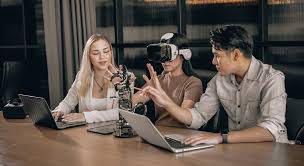
Extended Reality (XR) is shaking up the traditional learning paradigm, offering immersive and engaging experiences that could redefine education. This comprehensive term encompasses Virtual Reality (VR), Augmented Reality (AR), and Mixed Reality (MR), each bringing a unique set of innovations for the future of learning.
1. Virtual Field Trips – VR negates geographical and temporal boundaries, allowing students to embark on field trips to distant lands, historical eras, or even outer space, from the comfort of their classroom. This not only enhances engagement but also accessibility for learners who are otherwise unable to participate in physical travel.
2. AR Enhanced Textbooks – Imagine pointing a smartphone at a textbook and seeing the diagrams leap off the page in 3D. AR can bring complex concepts to life, providing a tangible understanding of abstract topics. From dissecting a frog to visualizing mathematical figures, this technology fosters interactive learning opportunities.
3. Immersive Language Learning – Language acquisition can thrive with XR through simulated conversations and environments where learners practice new languages as if they were in a country where it’s spoken natively. By conversing with virtual characters or navigating foreign streets via MR, learners acquire practical language skills more effectively.
4. Skill-Based Training Simulations – VR simulations provide safe environments where learners can practice procedures from surgery to machinery operation without real-world risks. This hands-on approach accelerates skill acquisition, builds confidence, and enables repeated practice until mastery is achieved.
5. Collaborative Learning Spaces – XR creates shared virtual workspaces for remote learners to collaborate on projects as if they were in the same room. Interactive whiteboards and 3D modeling enhance group tasks across different locations, developing teamwork skills and enabling collective problem solving.
6. Empathy Building Exercises – By placing students in someone else’s shoes through VR experiences, such as those simulating historical events or personal challenges faced by others, XR promotes empathy and social awareness. Such experiences can deeply affect how learners perceive the world and engage with others.
As XR technology matures and becomes more accessible, its potential to revolutionize educational practices grows exponentially. These six innovations hint at an exciting future for learning – one that is dynamic, student-centered, and ripe with opportunities for discovery that extends well beyond the four walls of a classroom. With these tools in hand, educators can craft compelling educational experiences that could dramatically improve retention rates and foster a lifelong love for learning.
